Last Updated on September 2, 2025 by Ewen Finser
Statsig is an all-in-one product development platform that has a wide array of integrated features that make it an excellent tool for organizations that are looking to run experimentation on products and delve into their user analytics and data. While there are several tools out there, Statsig really stands out for its product experimentation features.
Who should use Statsig?
Statsig is best suited for product and engineering teams who need to experiment, run A/B tests, measure product metrics, and understand user behavior.
TL;DR:
Statsig is a scalable, all-in-one product management platform that is built for mid-to-large-sized organizations looking to experiment, deliver, and ship products quickly and at scale.
With advanced experimentation features, customizable feature management functionality, and intricate analytic tools such as session replays and more, businesses can gain an excellent understanding of user behavior. Statsig can be complex and requires sufficient technical know-how to ensure teams can get the most out of the platform. With scalable pricing tiers from free to enterprise plans, it’s an accessible, feature-rich platform for product-focused organizations.
Statsig Standout Features

1. Advanced Experimentation Functionality
Product teams know how costly and time-consuming it can be to experiment. I like that Statsig’s platform allows you to run end-to-end experimentation efficiently within the tool.
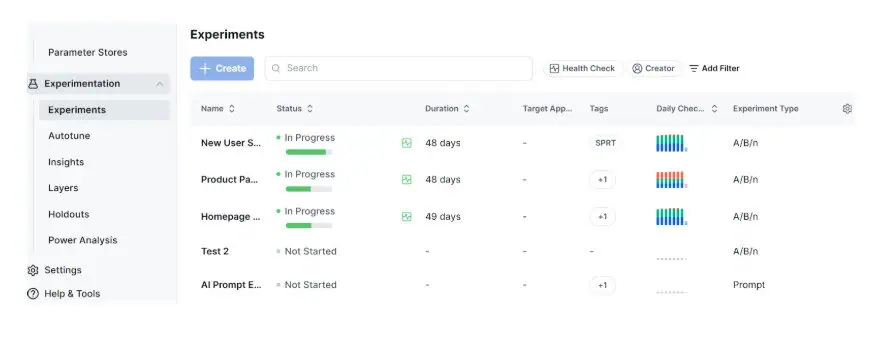
Being able to filter out critical information is crucial when monitoring experiments, which is easy on the platform, too. You can easily surface warnings or any other important data.
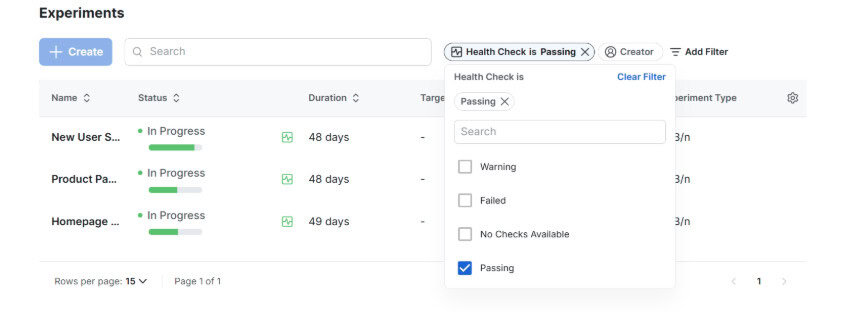
When needing to create multi-variant testing (A/B or A/B/n) on the platform, this can be configured based on your chosen variables. This allows you to test multiple aspects of your product to understand what impact features have at a large scale. Minimizing risk and measuring impact before releasing new features is critical for organizations to validate their system and product.
Autotune (Bayesian) feature on Statsig:
Autotune is a valuable feature within Statsig, which allows you to track performance against a key metric. It then automates traffic towards the best-performing variant, allowing you to save time and ensure users have the best experience faster.
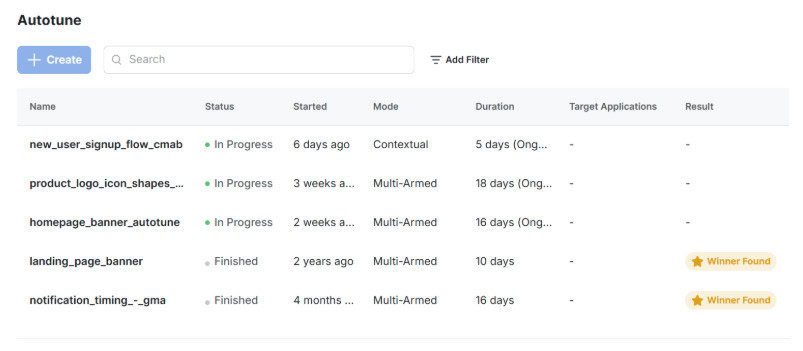
Experimentation insights:
Without advanced analytics, experimentation would not be as valuable to product teams.
I love that Statsig allows you to drill down into specific metrics depending on your business goals.
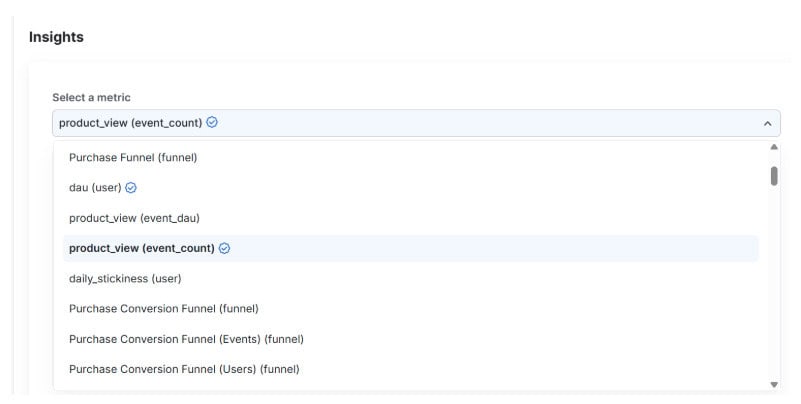
Multiple insights can help teams identify positive or negative trends over a customizable date range.

Feature pros:
- Overall, Statsig has great tools within each feature that allow you to drill down and automate even further, which I like.
- Real-time and customizable insights can be surfaced easily from within the app.
- Real-time monitoring can offer businesses insights into KPI metrics, while testing with the use of tools like Autotune.
- Autotune also allows you to surface insights faster than traditional A/B testing.
- Statsig has excellent features to set up low-code experimentation, ideal for marketing-focused teams that don’t have advanced technical skills to set up complex configurations.
2. Feature Management and Tools
Feature flags:
Feature flags, feature gates, or killswitches are useful for teams that need the flexibility to toggle on/off specific feature sets for particular users without the need to deploy code.
If your product teams need a safe way to release features gradually, using a feature flag is really valuable.
You can set up feature gates depending on key metrics or users.

Statsig also has handy features like alerts, which can be set up based on specific variables to ensure you’re monitoring key events.
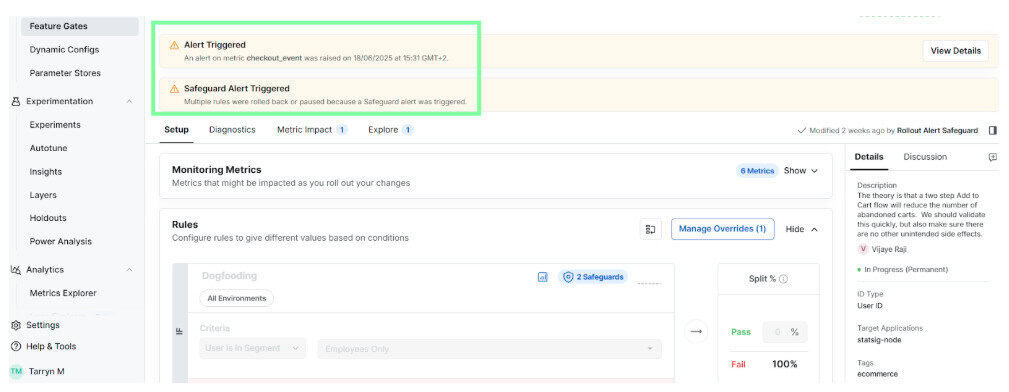
Safeguards are also a super handy tool to have when you need to automate specific actions that kick in based on a trigger or series of events.
Safeguards monitor Rollout or Topline alerts depending on what you choose to configure for your feature gate.
Safeguards and automated alerts can be really valuable when you don’t have the resources or time to monitor all risk events or thresholds.
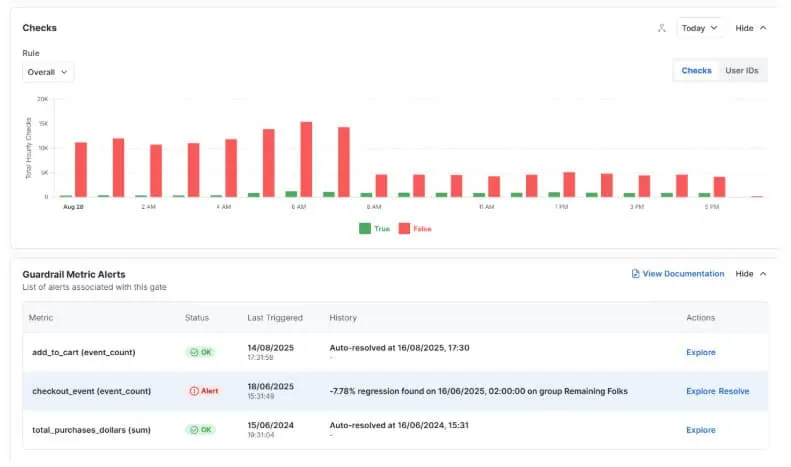
Feature pros:
- Statsig lets you configure your feature gates based on a wide range of criteria, which can be customized to your requirements.
- Feature gates help you roll out specific features safely and gradually to ensure you’re reducing risk.
- Stastig has a killswitch that can be used when issues are experienced, allowing you to isolate and disable it without the need to deploy code.
- Automated features, such as safeguards, allow you to monitor alerts and act on them instantly before issues escalate and require additional code deployment.
- You can target your feature deployment to specific users who are segmented based on a particular set of criteria.
3. Advanced Analytics and Monitoring
Statsig really goes the extra mile when it comes to analytics and dashboards that can be configured to monitor various events and metrics.
For organizations or product teams that need to measure specific variables, this is an ideal solution.
You can use suggested metrics and configure date ranges depending on your requirements.
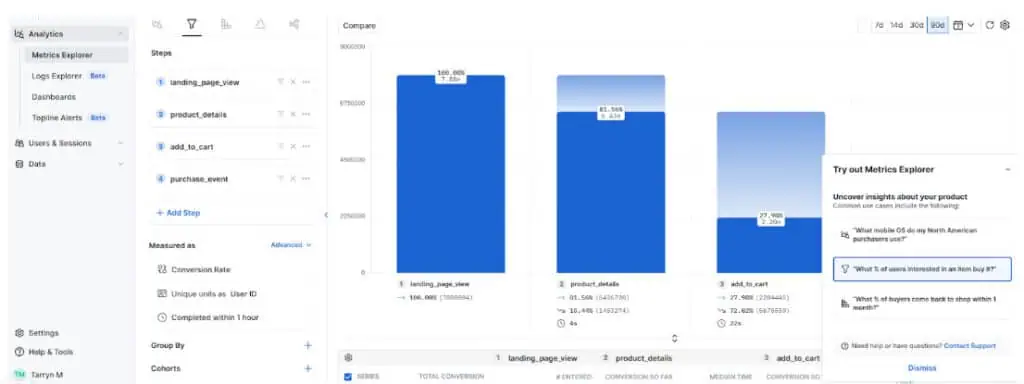
Statsig also allows additional drill-downs into specific metrics. Understanding customer behavior and engagement is critical, and having the tools to analyse this further is really valuable.
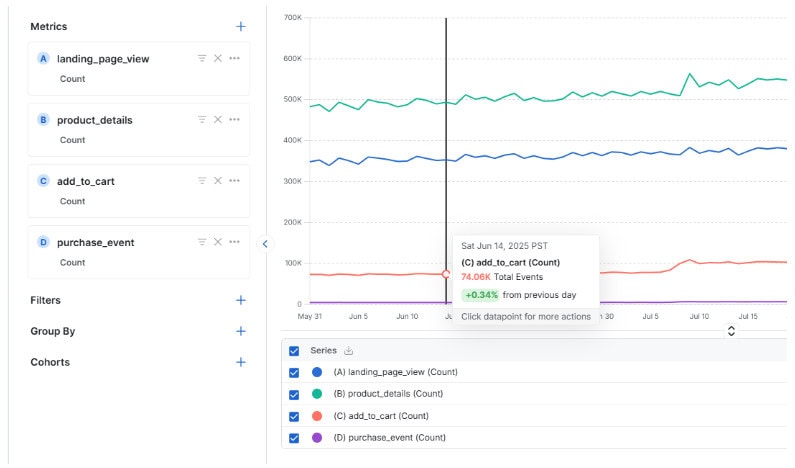
Another great feature of Stastig’s analytics is having the ability to monitor key user behavior and create an overview of user journeys.
User journeys allow you to monitor key behavior and understand where favorable or unfavorable user activity is happening and what the results of that are.
For example, the following shows interactions between customers performing an activity such as “adding to cart” and the linked monitored activity. Monitoring and tracking interactions between key actions can be tricky to measure without the use of a tool and can be exceptionally time-consuming for teams.
Understanding drop-off rates and why they happen at key steps can give you insights so that you can make changes to your product where it matters and improve revenue or user experience over time.
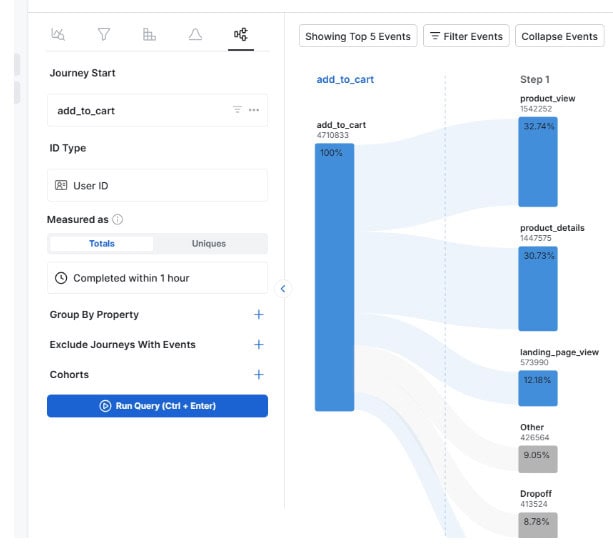
Feature pros:
- Statsig allows you to drill down into key analytics and metrics, which can be configured depending on what you want to surface.
- A consolidated set of metrics allows your organization to measure multiple aspects of your product in a single tool. A single overview of data via dashboards means you can monitor how multiple products behave in one place, too.
- Real-time monitoring of key events allows you to make changes at important intervals, rather than waiting; you can act proactively and avoid issues or negative user experience.
- Stakeholders can gain a holistic view of multiple metrics in a single tool.
- You can set up alerts within the analytics tool to monitor trends and any warning signs early on.
- Customized dashboards allow you to set up specific metrics to monitor how product decisions are performing and validate further actions.
4. Other Notable Value-Adds and Features.
Statsig has so many great features, I’d recommend looking into their product to see which of these would be a significant value-add for your organization.
Here are some other standout features you can look out for in their tool:
- Session replays – This is one of those really valuable insights that can genuinely help product teams monitor user behavior. Whereas metrics can be misinterpreted in some cases, watching users interact with your platform can assist teams in understanding real human behavior and the use of your product.
Session replays also allow you to identify bugs or issues with ease, helping you to fix problems quickly without needing to request additional information.

- Web analytics – You can track details about how users are interacting with your website. Monitoring visitor stats can help drive better decisions around visitors, such as error rates, drop-offs, unique site visits, and more. If you have a marketing team that may need additional insights into elements like Google Analytics, this is a great addition.
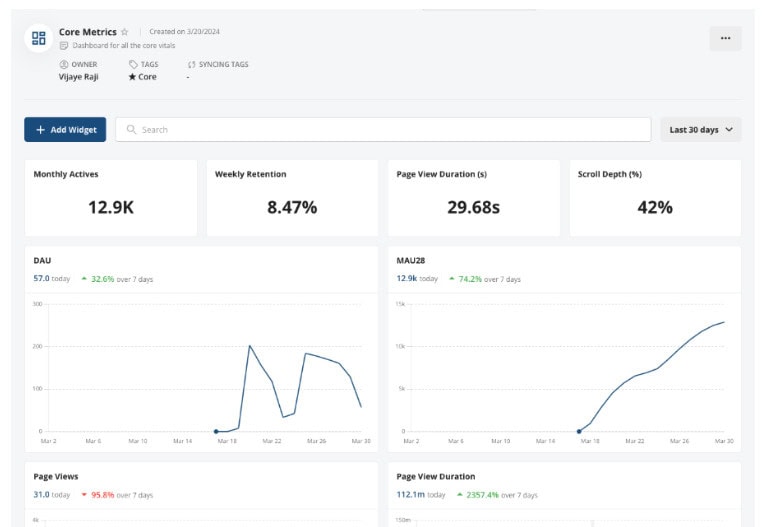
Statsig Pricing
Statsig has three pricing tiers, which can be chosen based on your requirements. They do offer a free trial, which I’d suggest trying out! There are so many great features in the tool that I haven’t covered in this review, so I recommend taking a peek at the platform to get a better view.
Here’s a quick overview of what features are included
- Developer – Best for small teams or single users
- Pro – Best for large or growing product teams
- Enterprise – Best for enterprise-level organizations that need to scale
Feature | Developer | Pro | Enterprise |
Pricing | Free (no credit card required) | $150 per month | Custom pricing available upon request |
Events | 2M events per month | 5M events per month | Event or Experiment-based contracts, depending on your requirements |
Session replays | 50,000 session replays per month | 100,000 session replays per month, then charged thereafter (per 1000 events) | Warehouse native deployment |
Experimentation | Basic experimentation No code experimentation | Everything in developer plus advanced experimentation | Advanced experimentation features, including custom queries, holdouts, and more |
Feature Management | Basic and advanced feature management, including feature flagging, rollout, and targeting | Basic and advanced feature management, including feature flagging, rollout, and targeting | Basic and advanced feature management, including feature flagging, rollout, and targeting |
Analytics | Advanced analytics (excluding conversion drivers) Includes data retention (1 year) | Advanced analytics Includes data retention (unlimited) | Advanced analytics Includes data retention (unlimited and customizable) |
Session Replays | Advanced options, including web & mobile session replays Session replays are retained for 30 days. | Advanced options, including web & mobile session replays Session replays are retained for 30 days. | Advanced options, including web & mobile session replays Custom retention for session replays |
Governance | Access control not included | Access control not included | Access control included |
Project and team | Change logs included – no other features | Change logs Change reverts and Change review & approval workflow | All features in Pro plus organization & management, multiple projects, and team-level permissions |
Statsig Pros and Cons:
Pros | Cons |
Free plan available, ideal for smaller product teams or individual users. (Ideal for startups). The free plan has generous features included | The platform can be quite complex and overwhelming to set up for smaller organizations. May require lengthy onboarding. |
Overall, excellent ease of use and user-friendly interface | Requires specific configuration to get the best out of the tool |
Excellent experimentation features. Great value add for both small and large organizations. | Experimentation data must be interpreted correctly to gain accurate insights |
Great overall “all-in-one” platform. Reduces the need for disparate systems. Allows a single view of multiple tools and features. | Can become expensive if additional or advanced tooling is required. |
Specific features, such as Safeguards, allow users to get real-time alerts to ensure users can react proactively to issues or potential risks. | Specific features, such as Safeguards, are only available on higher tiers (Pro and Enterprise plans). |
SDKs and integrations are available with user guidance and documentation available on the platform. | Technical expertise would be required to configure and set this up successfully. |
In summary, Statsig is a well-rounded tool with diverse capabilities when it comes to delivering experimentation, feature management, and advanced analytics that can help drive better product decisions faster. I like that Statsig also caters to multiple team sizes, from small startups right through to enterprise-level organizations that need highly advanced analytics and features.
I recommend that less-technical organizations or teams spend sufficient time onboarding and understanding how to configure the platform and specific features to ensure they can derive actual value from the tool.

